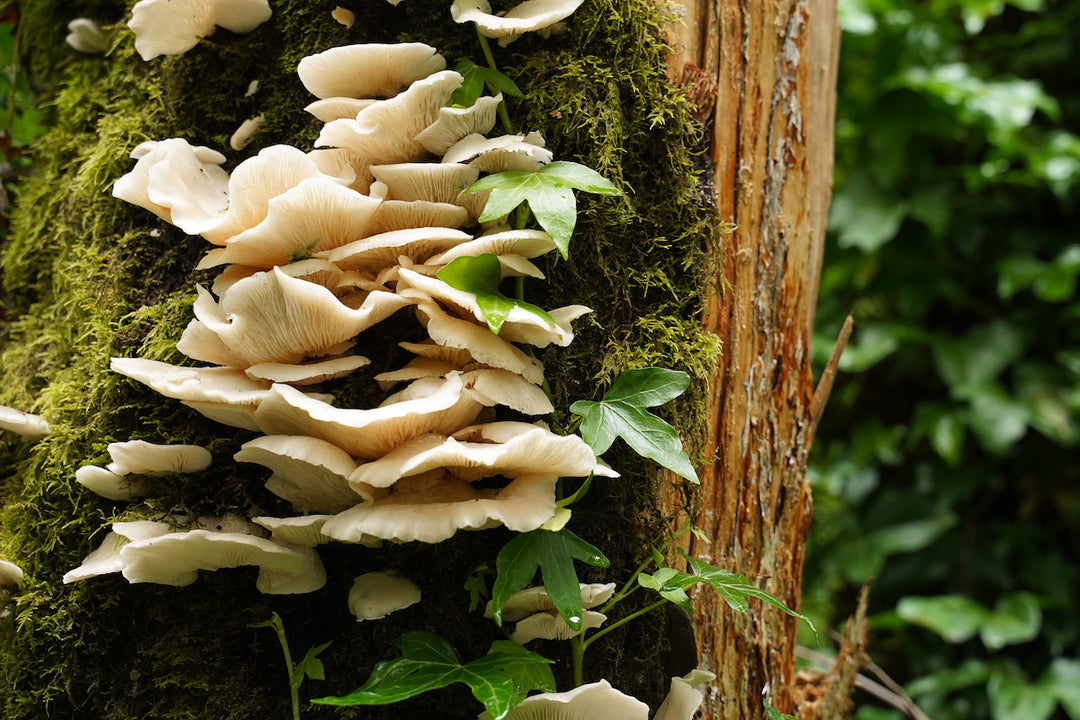7 Mushroom Innovations That Are Changing the World

At the heart of innovation in science and technology, nature has often served as the cornerstone of inspiration. The natural world provides us with seemingly infinite marvels that act as templates for human achievements. One area in particular we have started to pay more attention to in the past few years is the word of mushrooms.
Mushrooms, and more specifically, their underground network of thread-like mycelium, are increasingly being recognized for their potential to revolutionize various industries through unique applications.
From sustainable packaging and building materials to batteries and sensors, the versatile and adaptive nature of mushrooms offers a glimpse into a future where ecology and technology can work together to offer innovative solutions.
Here, we’ll touch on a few of the fascinating ways mushrooms are being used to address modern challenges and pave the way for a more sustainable and eco-friendly future.
1. Developing Sustainable Products with Mycelium

Mycelium, the root-like structure of mushrooms, can be cultivated on agricultural waste such as corn stalks, sawdust, coffee grounds, and other food byproducts. It forms a dense network as it feeds off this bio-waste and can then be harvested, processed, and shaped into a variety of products.
Mushroom Leather
Mycelium is now being used to make mushroom-based leather. It is a cruelty-free and vegan alternative to animal leather. It is biodegradable, and in terms of quality, mushroom leather is comparable to animal leather in its durability and appearance. It can be dyed, embossed, and treated to mimic the look and feel of real leather. Mushroom leather is still a relatively new and niche material, but it holds great promise as a sustainable alternative to more traditional options.
Sustainable Packaging
Mushroom packaging materials are a sustainable and renewable substitute for traditional petroleum-based packaging such as styrofoam and other plastics.
Mushroom packaging is lightweight yet strong. It is also insulating, fire-retardant and fully biodegradable, which further illustrates its utility. Several companies have already begun using mushroom packaging for their products, paving the way for better packaging options for future product developers.
Building Materials & Insulation
Engineers working with mushroom-based material are finding ways to replace some traditional construction materials. These ingredients are made from mushroom mycelium, which acts as a natural binder used in conjunction with more fibrous forms of agricultural waste such as wood chips, straw, or hemp fibers.
In terms of performance, mushroom-based building components are lightweight and versatile. They can be used for insulation, soundproofing, and in some cases in the structural components of buildings. They are also fire-resistant and can even help improve indoor air quality by absorbing and decomposing harmful volatile organic compounds.
Mushroom-based materials are very biodegradable, meaning they can be composted at the end of their life cycle. We expect these mycelium building blocks to find their way onto job sites in the near future.
Foam Pads & Furniture
Another fun application of mycelium is in the construction of foam pads and other furniture items. Its ability to be formed into many shapes of various densities makes it a good material for a variety of applications.
One of the main ways mushroom-based materials are used in furniture is in creating soft, foam-like padding. However, they are also being used to create structural components for furniture like table legs, chair frames, and various other elements.
And again, these materials are renewable, biodegradable, and can be produced with minimal environmental impact. As more and more consumers look for ways to reduce their environmental impact, these types of products will become more common.
2. Replacing Caskets with "Mushroom Death Suits"

One of the most interesting new ways mushrooms are being used is as a replacement for caskets. In this process, mushroom burial suits are used as a more environmentally friendly alternative to traditional burial practices. This approach, ideated by Jae Rhim Lee, uses the power of mushrooms to aid in the breakdown of human remains, promoting natural decomposition and nutrient cycling in the soil.
As an alternative to conventional burial practices, which often involve embalming fluids and other non-biodegradable materials that can harm the environment, mushroom burial aims to return the body to the earth in a way that nourishes the soil and promotes new life.
It is still a relatively new concept, but has gained a lot of attention. Advocates of mushroom burial believe that it could help reduce the carbon footprint of traditional burial practices and promote a more natural approach to death care.
It's important to note that mushroom burial is not yet widely practiced and may not be available to everyone. Regulations regarding burial practices vary a lot, so it's important to look into the laws in your area before considering mushroom burial.
3. Healing the Earth with Bioremediation
Mushrooms are now being used for bioremediation, a process that uses living organisms to remove or neutralize contaminants in polluted areas. Using fungi, this process is called mycoremediation and it harnesses the natural ability of certain mushrooms to break down and metabolize a wide range of pollutants, including hydrocarbons, pesticides, heavy metals, and even some radioactive materials.
Mushrooms are also able to detoxify pollutants through a process called mycofiltration, where mycelium acts as a filter, trapping and neutralizing contaminants as they pass through it. This can be particularly effective in filtering water contaminated with bacteria, viruses, and other pathogens. Additionally, mycofiltration does not require the use of chemicals or energy-intensive manufacturing processes, making it a low-impact solution for water treatment.
One of the big advantages of using mushrooms for bioremediation applications is their ability to thrive in a wide range of environments and to colonize difficult-to-access spots. And while more research is needed in these areas, mushrooms are showing great promise as a natural and sustainable solution for cleaning up all types of pollution.
4. Generating Electrical Signals with Mushrooms

Mushrooms are even being explored as a sustainable alternative to traditional materials used in electronics, including circuit boards. This approach involves using mycelium as a substrate to shape and even grow electronic components.
Unlike traditional circuit boards, which are made from non-biodegradable materials like fiberglass and epoxy resins, mushroom-based circuit boards can be easily composted at the end of their life cycle, reducing electronic waste. This is especially significant, as e-waste totals to more than 50 millions tons globally each year.
Additionally, mycelium has natural adhesive properties, which can also help eliminate the need for other toxic chemicals used in traditional circuit board manufacturing.
While the use of mushrooms in electronics is also still a relatively new development, many companies are exploring ways to harness these unique properties.
5. Exploring the Sensory Abilities of Mycelium

Other ways mushrooms are being explored for use in electronics is in sensor technologies. Mushrooms show great ability to respond to various environmental stimuli, giving them potential application across a variety of sensor types.
Mushrooms can be used to detect environmental conditions such as humidity, temperature, and light. Their porous structure allows them to absorb and release moisture, making them sensitive to changes in humidity. This trait can be harnessed to create sensors for agriculture and help with climate control in building automation.
Mushrooms can also be used as biological sensors to detect specific substances or compounds. For example, researchers have developed biosensors using mushroom cells that can detect heavy metals in water. The cells react to the presence of these substances by changing color, providing a visual indication of contamination. So not only can they help filter water as mentioned earlier, but they can help monitor the quality before and after as well.
Some mushrooms have even been found to be sensitive to certain types of gas, such as carbon dioxide and methane. By looking to mushroom-based materials for gas sensing, researchers can create sensors that detect the presence of these gasses in environment or industrial settings.
The flexible and lightweight nature of mushrooms makes them theoretically suitable for use in wearable sensors. Researchers have begun development of a wearable sensor using a mushroom-based ingredient that can monitor body temperature and humidity, making it useful for applications in healthcare and sports performance.
Overall, mushrooms show great potential for use in sensor technology and continued research in this area could lead to some very cool and environmentally-friendly tools.
6. Using Mushrooms to Store & Process Information
Mushrooms are also having an influence on the field of biocomputing. It has been discovered that mushrooms may have the potential to store and even process information. However, harnessing these complex mycelial networks as a form of wetware may mostly be theory at this point.
Right now it seems like the complex inner workings of mycelial networks are acting mostly as a guide to help us develop new ways of designing more traditional systems, though it may one day lead to new biological based systems altogether.
As far as data storage goes, researchers have recently demonstrated the feasibility of using DNA extracted from mushrooms to store digital information. This approach, known as DNA data storage, could offer a more compact and environmentally friendly alternative to traditional data storage methods. As the world's data storage needs rapidly increase, alternative systems like these may help ease some of the burden.
7. Creating Batteries from Nature
One of the strangest applications of mushrooms in modern technology is as alternatives to traditional batteries. These new, nature-based batteries are made from cellulose nanofibers derived from the cell walls of mushrooms. The cells are being used to replace graphite electrodes in today's lithium ion batteries.
The porous structure of the mushroom skin allows for better ion transport, and researchers have developed an electrode material using carbonized mushroom skin that has already shown very promising performance.
In addition to standard lithium ion battery application, certain mushrooms are being researched for their potential use in flow-cell batteries. A chemical found in one particular type of mushroom has been shown to have a high affinity for Vanadium, a key component in these types of batteries. This interaction may lead to key developments that could help make these types of batteries more widely used.
Furthermore, some researchers are even exploring the use of mushrooms as living organisms in biological batteries, harnessing the natural metabolic processes of mushrooms to generate electricity. The use of these types of batteries is mostly hypothetical at this point, as they do not produce much electricity, but the idea is still very intriguing.
Final Thoughts on Mushroom Innovations
As our world progresses and society is faced everyday with new global challenges, we have found ourselves looking back to nature more and more for answers to complex problems.
Some of these answers have been hiding in plain sight, waiting for us to learn how to look. Mushrooms have been used for centuries by mankind for food and medicine, but we have only recently, though advancements in technology, been given the tools to better understand them.
Now that general awareness is growing around how truly amazing mushrooms are, we have found an incredible ally that can hopefully help us on our journey as a species. And if we look and listen carefully, we may learn to harness mushrooms’ potential and build a brighter future for everyone.



Leave a comment